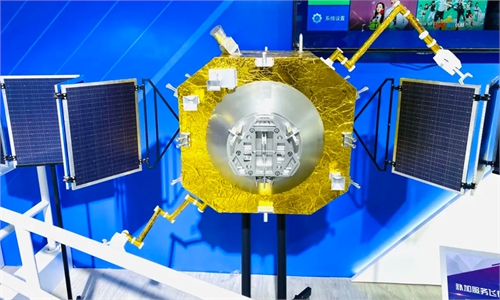China launches first Sun-probing satellite, advancing into 'era of solar exploration'
China on Thursday evening successfully launched the country's first Sun-probing science and technology experiment satellite into designated orbit, which will enable the world's first imaging spectrometer observation of the H-alpha band of the Sun, marking the country's advancement into the solar exploration era.
The satellite was launched into space with other 10 satellites in a single launch performed by the liquid-fueled Long March-2D carrier rocket from Taiyuan Satellite Launch Center in North China's Shanxi Province at around 7 pm on Thursday.
Shanghai Academy of Spaceflight Technology (SAST), the designer and manufacturer of the satellite, told the Global Times in a statement that the satellite weighs 510 kilograms, and will operate at an altitude of 517 kilometers in the dusk-dawn sun-synchronous orbit.
It's equipped with an imaging spectrometer, which will be the first in the world to conduct spectral imaging observations of the H-alpha band of the Sun.
The H-alpha band is one of the best spectral lines to study solar activity. By analyzing the data of this line, we can obtain changes of physical quantities such as atmospheric temperature and velocity during a solar eruption, and study the dynamical process and physical mechanism of the solar eruption.
Also marking a first, the satellite will apply magnetic levitation technology in orbit to increase accuracy and stability during operation.
The "gold-medal rocket," scoring its perfect performances that delivered all of its 54 launch missions in success in the past 30 years, has a liftoff thrust of 300 tons that is capable of carrying 1.2 tons of loads to the 700-kilometer sun-synchronous circular orbit, and is able to launch multiple satellites with different orbital requirements in one go.
Over the past 30 years, Long March-2D has sent a variety of heavyweights in China's satellite history, including the Quantum Experiments at Space Scale nicknamed Mozi, Dark Matter Particle Explorer "Wukong" or "Monkey King," and carbon dioxide monitoring satellite TanSat.
The rocket will also test the first attempt to use waffle-like grid fins to accurately guide fallen rocket pieces to Earth. It will control the attitude of the first stage of the rocket while it returns to Earth. It's capable of reducing the landing area by more than 80 percent, making the vehicle's landing point more accurate and controllable, greatly improving the safety of the surrounding environment.
Another highlight of the mission is that the satellite uses laser and microwave communication methods to set up a 5G high-speed communication channel, which further enhances the efficiency and reliability of inter-satellite communication.




